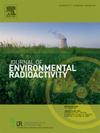风沙沉积物中人为钚同位素的记录:追踪中国北方半干旱沙丘地带的全球沉降物
IF 1.9
3区 环境科学与生态学
Q3 ENVIRONMENTAL SCIENCES
引用次数: 0
摘要
本研究利用灌木截留风沙形成的nebkhas—风成沙丘中保存的钚(Pu)同位素,重建了中国北方毛乌素半干旱沙丘场的环境变化。两个涅布哈剖面的分析结果显示,240Pu/239Pu原子比率始终接近0.18,表明主要来源是全球沉降物,罗布泊或塞米巴拉金斯克核试验或切尔诺贝利事故对当地没有显著贡献。总钚存量(308±3 Bq/m2和402±3 Bq/m2)大大超过直接大气沉降值(66 Bq/m2),表明远端和近端含钚沉积物都是通过风输送积累的。239+240Pu活度(0.005 ~ 0.387 mBq/g)的深度分布表现为1963年的单峰,1952年前后开始,与137Cs和OSL测年结果一致,验证了Pu同位素是可靠的年代地层标志。与20世纪60年代至70年代相比,过去20年的沉积物沉积率有所下降,这可能是由于沙尘暴活动和风速减少,这可能与区域造林和土地利用变化有关。这项研究证明了全球Pu污染的广泛性,甚至在偏远的沙漠中也是如此,并强调了nebhas作为重建大气沉积和环境变化的新地质档案。通过提供钚沉积的直接记录,这项工作促进了对干旱地区钚来源、运输和行为的理解,对利用放射性核素研究风成过程和环境演化具有更广泛的意义。本文章由计算机程序翻译,如有差异,请以英文原文为准。

Records of anthropogenic plutonium isotopes in wind-blown sand deposits: Tracing global fallout in northern China's semi-arid dune fields
This study investigates plutonium (Pu) isotopes preserved in nebkhas--aeolian dunes formed by shrubs intercepting wind-blown sands to reconstruct environmental changes in the semi-arid Mu Us dune field, northern China. Analysis results of two nebkha profiles reveal that the 240Pu/239Pu atom ratios consistently approximate 0.18, indicating a dominant source from global fallout, with no significant local contributions from the Lop Nor or Semipalatinsk nuclear tests or the Chernobyl accident. Total Pu inventories (308 ± 3 Bq/m2 and 402 ± 3 Bq/m2) highly exceed the direct atmospheric fallout value (66 Bq/m2), suggesting accumulation of both distant and proximal Pu-bearing sediments transported by wind. Depth distributions of 239+240Pu activities (0.005–0.387 mBq/g) show a single-peak corresponding to 1963 and an onset around 1952, consistent with previous 137Cs and optically stimulated luminescence (OSL) dating results, validating Pu isotopes as reliable chronostratigraphic markers. Sediment deposition rates have declined over the past 20 years compared to the 1960s–1970s, likely due to reduced sandstorm activity and wind speed, potentially linked to regional afforestation and land-use changes. This study demonstrates the widespread nature of global Pu contamination—even in remote deserts, and highlights nebkhas as a novel geological archive for reconstructing atmospheric deposition and environmental changes. By providing a direct record of Pu deposition, this work advances understanding of Pu sources, transport, and behavior in arid regions, with broader implications for using radionuclides to study aeolian processes and environmental evolution.
求助全文
通过发布文献求助,成功后即可免费获取论文全文。
去求助
来源期刊

Journal of environmental radioactivity
环境科学-环境科学
CiteScore
4.70
自引率
13.00%
发文量
209
审稿时长
73 days
期刊介绍:
The Journal of Environmental Radioactivity provides a coherent international forum for publication of original research or review papers on any aspect of the occurrence of radioactivity in natural systems.
Relevant subject areas range from applications of environmental radionuclides as mechanistic or timescale tracers of natural processes to assessments of the radioecological or radiological effects of ambient radioactivity. Papers deal with naturally occurring nuclides or with those created and released by man through nuclear weapons manufacture and testing, energy production, fuel-cycle technology, etc. Reports on radioactivity in the oceans, sediments, rivers, lakes, groundwaters, soils, atmosphere and all divisions of the biosphere are welcomed, but these should not simply be of a monitoring nature unless the data are particularly innovative.
 求助内容:
求助内容: 应助结果提醒方式:
应助结果提醒方式:


